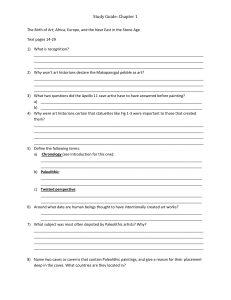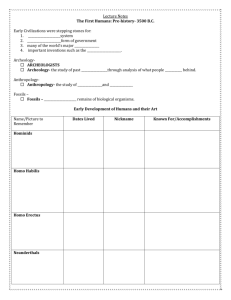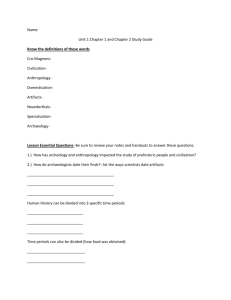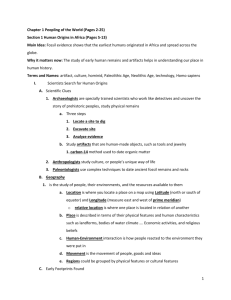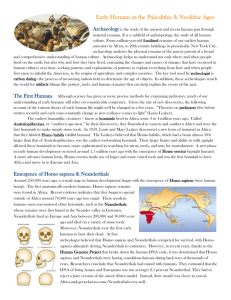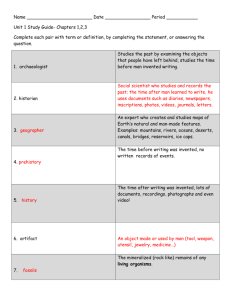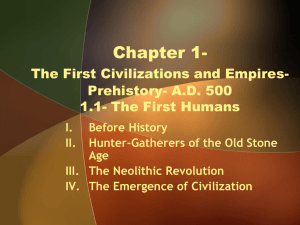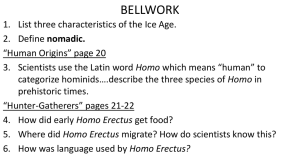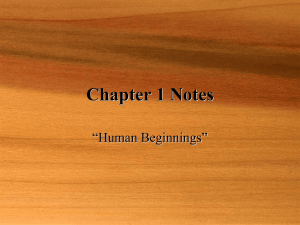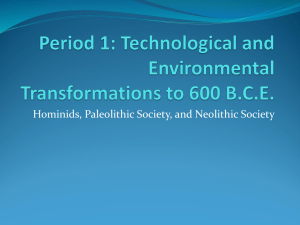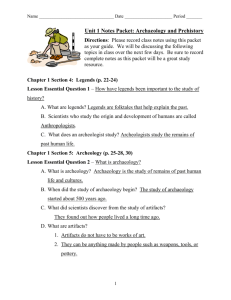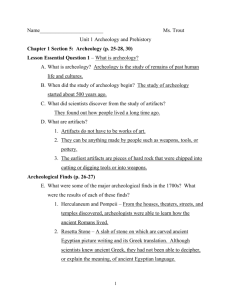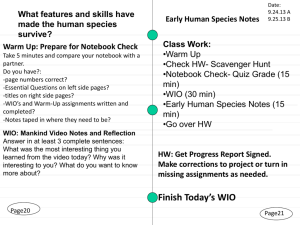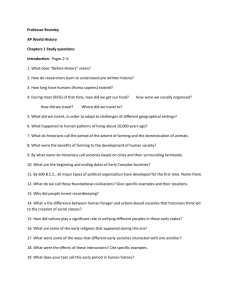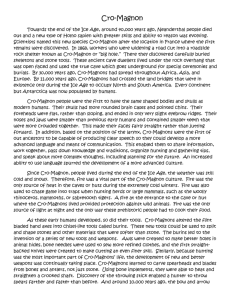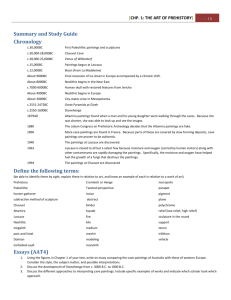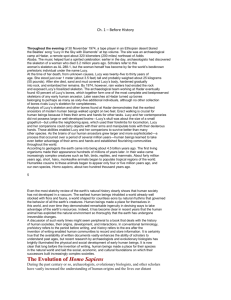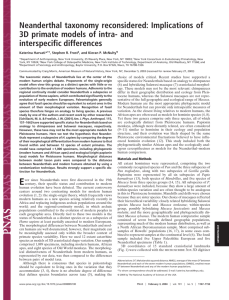1.6 Eras of Prehistory Outline
advertisement
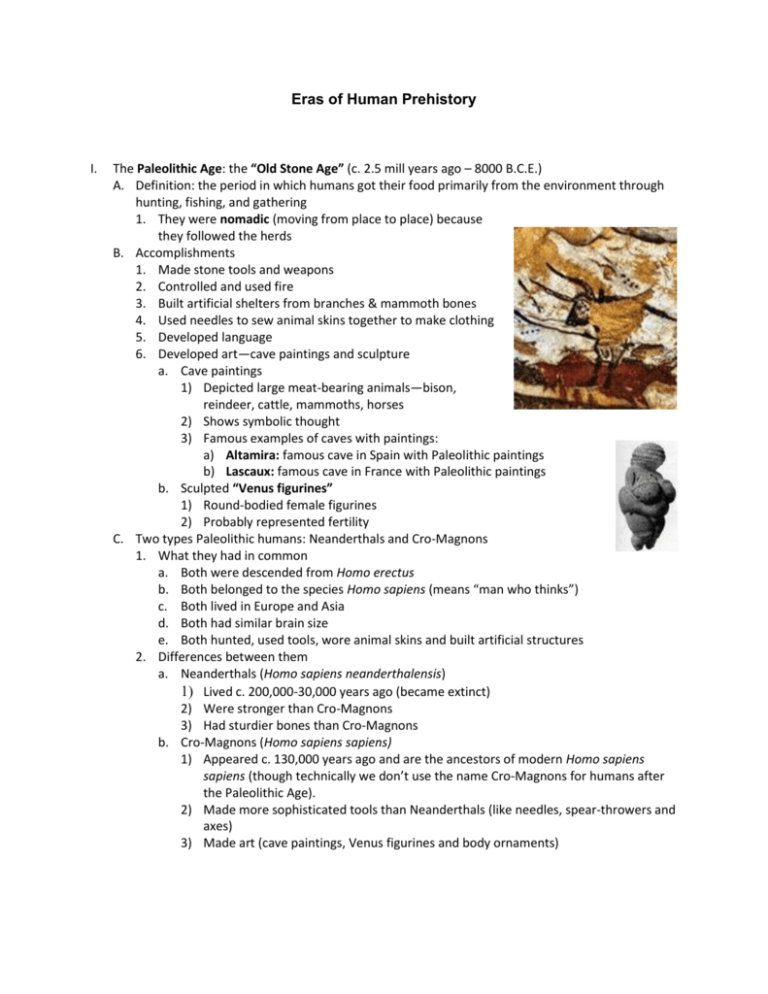
Eras of Human Prehistory I. The Paleolithic Age: the “Old Stone Age” (c. 2.5 mill years ago – 8000 B.C.E.) A. Definition: the period in which humans got their food primarily from the environment through hunting, fishing, and gathering 1. They were nomadic (moving from place to place) because they followed the herds B. Accomplishments 1. Made stone tools and weapons 2. Controlled and used fire 3. Built artificial shelters from branches & mammoth bones 4. Used needles to sew animal skins together to make clothing 5. Developed language 6. Developed art—cave paintings and sculpture a. Cave paintings 1) Depicted large meat-bearing animals—bison, reindeer, cattle, mammoths, horses 2) Shows symbolic thought 3) Famous examples of caves with paintings: a) Altamira: famous cave in Spain with Paleolithic paintings b) Lascaux: famous cave in France with Paleolithic paintings b. Sculpted “Venus figurines” 1) Round-bodied female figurines 2) Probably represented fertility C. Two types Paleolithic humans: Neanderthals and Cro-Magnons 1. What they had in common a. Both were descended from Homo erectus b. Both belonged to the species Homo sapiens (means “man who thinks”) c. Both lived in Europe and Asia d. Both had similar brain size e. Both hunted, used tools, wore animal skins and built artificial structures 2. Differences between them a. Neanderthals (Homo sapiens neanderthalensis) 1) Lived c. 200,000-30,000 years ago (became extinct) 2) Were stronger than Cro-Magnons 3) Had sturdier bones than Cro-Magnons b. Cro-Magnons (Homo sapiens sapiens) 1) Appeared c. 130,000 years ago and are the ancestors of modern Homo sapiens sapiens (though technically we don’t use the name Cro-Magnons for humans after the Paleolithic Age). 2) Made more sophisticated tools than Neanderthals (like needles, spear-throwers and axes) 3) Made art (cave paintings, Venus figurines and body ornaments) II. Agricultural Revolution (c. 8000 BCE) A. Defintion: A period of transition (change) in which humans changed from food-gathering to food-raising 1. “Revolution” means a dramatic change 2. Humans began to domesticate animals and grow crops, but still relied heavily on hunting B. Why did this change happen? 1. The most recent Ice Age ended and the Earth’s climate became warmer and drier 2. Food was harder to find, so humans had to raise it on their own C. Invention of Agriculture (raising crops) did not happen at the same time everywhere 1. Fertile Crescent and India: grew wheat and barley, beginning c. 8000 B.C.E. 2. China: grew rice and millet, beginning c. 6000 B.C.E. 3. Mexico: grew corn, squash, beans and potatoes, beginning c. 5000 B.C.E. D. Domestication of Animals (raising animals) 1. Sheep, goats and cattle for food 2. Dogs and horses to work with humans III. Neolithic Age: the “New Stone Age” (c. 8000 - 4000 BCE) A. Definition: the period in which people began to raise most of their own food, rather than going out and finding it through hunting and gathering B. Two types of Neolithic societies 1. Neolithic farmers a. Primary food source was agriculture b. Sedentary = staying in one place 1) Stayed in one place to tend crops 2) Built permanent structures for their homes 3) Established villages a) One of the oldest was Jericho (begun c. 8000 BCE), located in the West Bank region between modern-day Israel and Jordan b) Another well-known Neolithic community was Çatal Hüyük (c. 6700-5700 BCE), located in modern-day Turkey 2. Neolithic herders a. Primary food source was domesticated animals b. Nomadic = moving from place to place 1) Moved with their herds 2) So they built temporary structures 3) No villages
